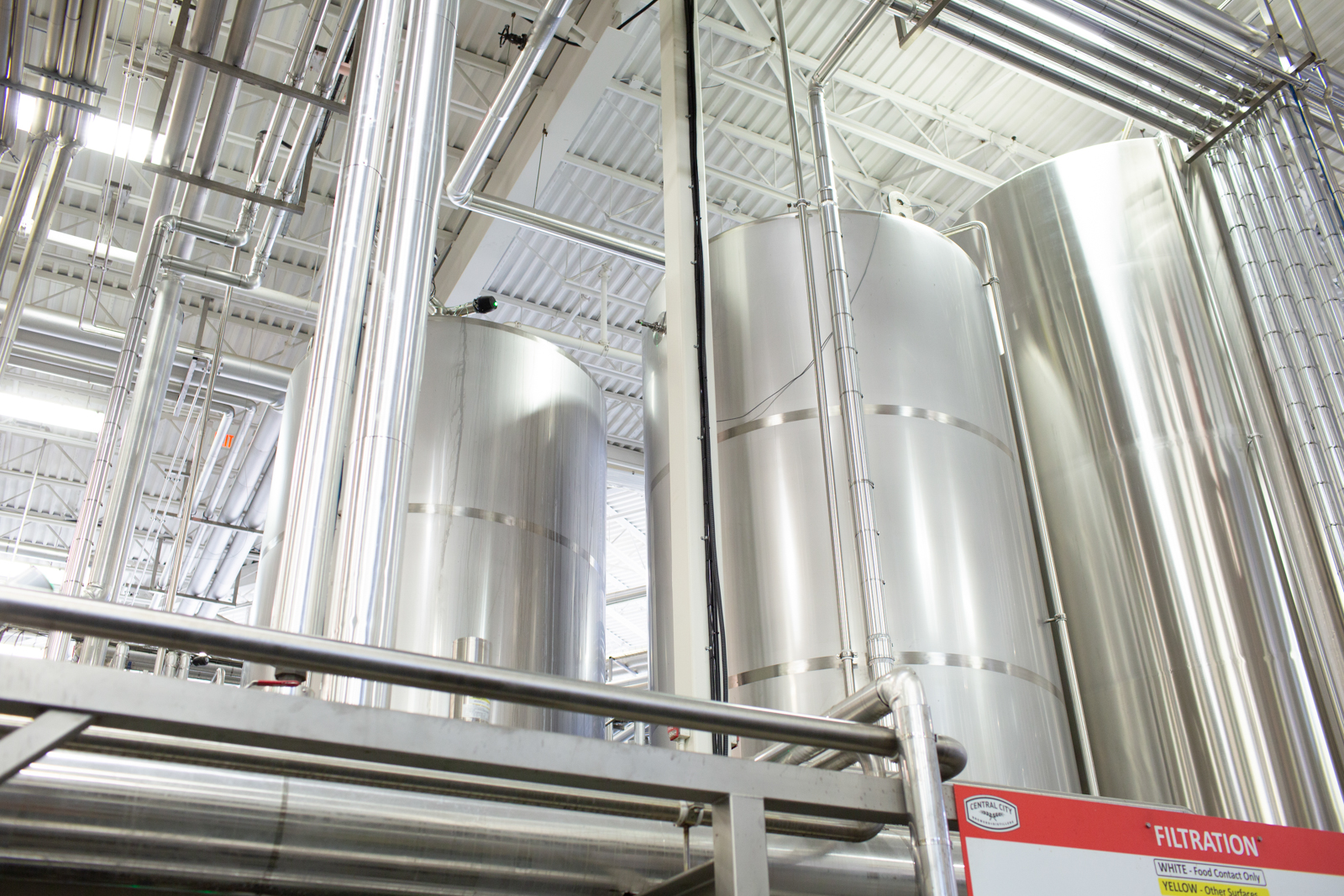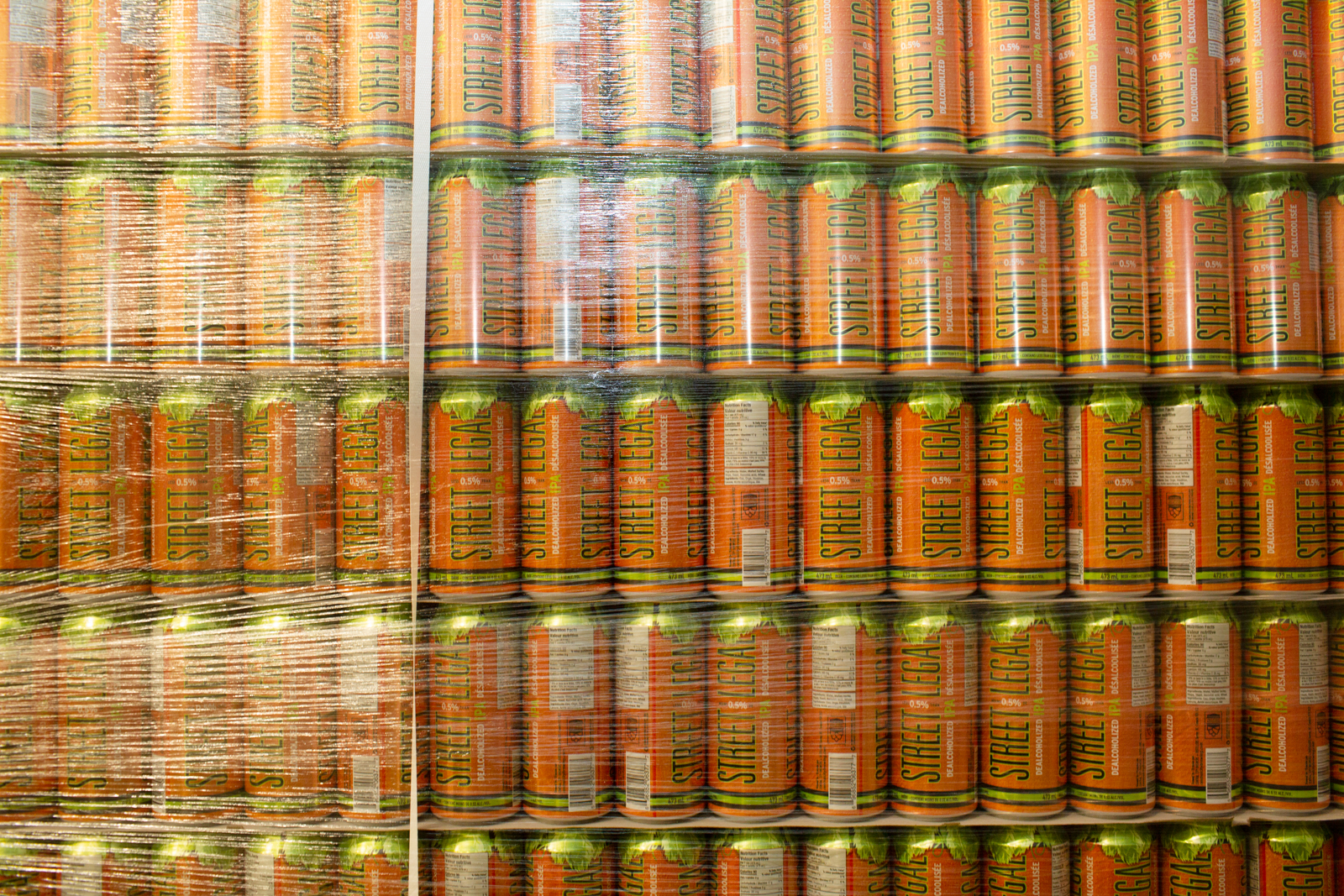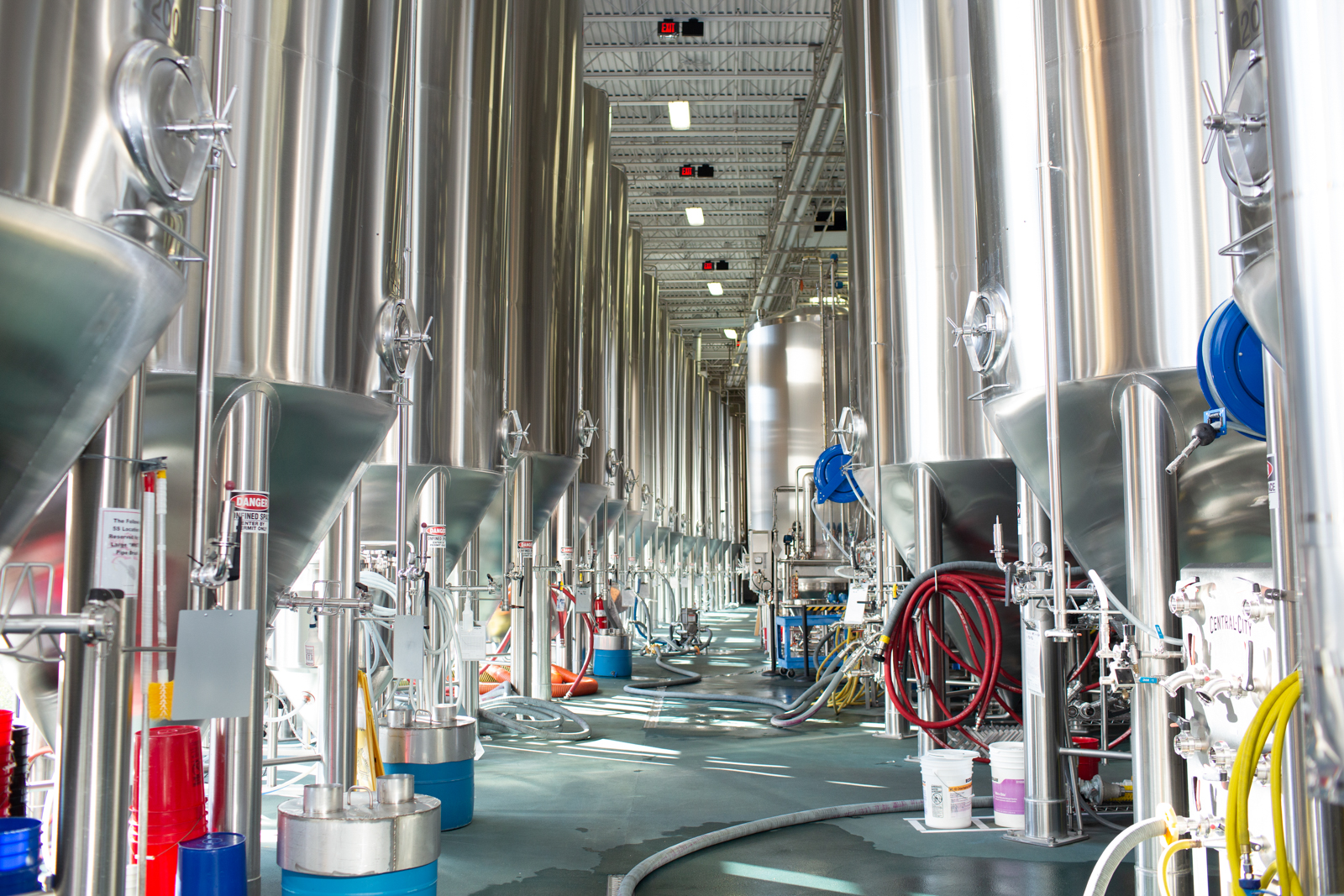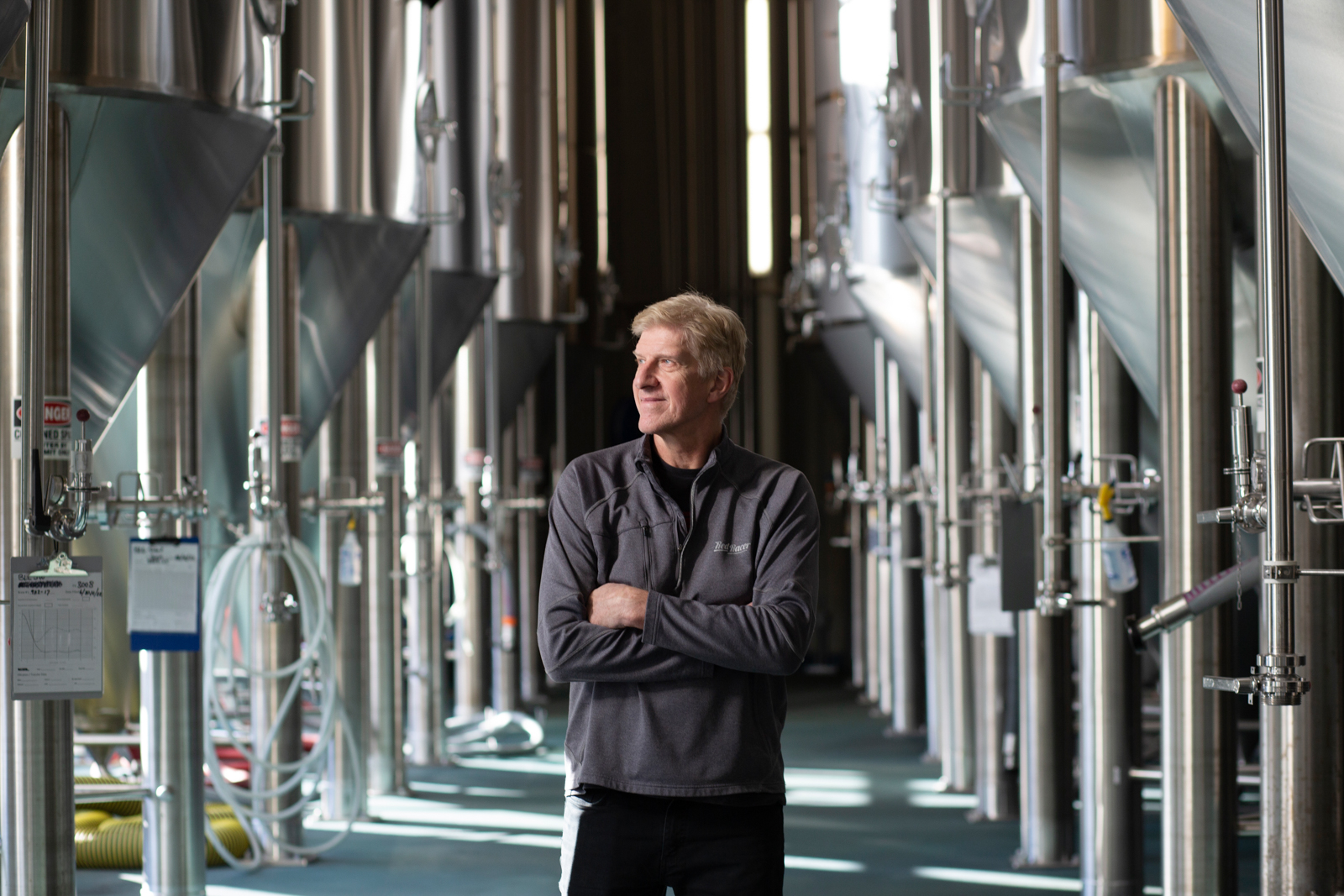“Our beers taste better than the big guys now,” says Gary Lohin.
In his taproom at Central City Brewers, he is excitedly helping me taste through each of five dealcoholized beers—my very first alcohol-free flight. The placebo is real. I feel guilty about the time of day; it’s lunchtime and I have to remind myself that I’m OK to drive. “You could crack one open in the car if you wanted,” says Lohin, laughing at my caution. But something in my psyche resists; would drinking so flippantly kill the placebo?
From light to dark, we sip our way through the five beers—a pilsner, wheat ale, pale ale, IPA (my personal favourite), and the nitro stout (a close second). When I ask Lohin how he makes his low-alcohol beers, his eyes light up: this is his happy place. He uses a membrane technology, a bit like a reverse osmosis system, which filters a fully aged beer to remove the alcohol along with some water from one vat to another. Clever math is needed here, he says, but generally the beer needs to dealcoholize down to around one per cent alcohol by volume (ABV) before adding some deaerated water back in, until the beer reduces to just below the 0.5 per cent ABV target—the legal limit that enables a beer to be labelled “non-alcoholic.”
Lohin started homebrewing in the early 1980s. With few others in competition, he frequently scooped up awards. He was noticed by Whistler Brewing, which gave him his first foot in the door. Finally, he learned the ropes in a professional setting, and before long he was offered a brewmaster position at Sailor Hagar’s in North Vancouver. After nine years at the Lower Mainland’s very first brew pub, Lohin met Darryl Frost who, in 2003, was starting up a little brew pub called Central City. Lohin joined Frost as brewmaster, and the duo grew the company into one of British Columbia’s largest brewers.
“It was probably about four or five years ago,” says Lohin, sitting opposite me. “I was travelling around Europe and noticed there was dealc everywhere.” The word dealc (DEE-ALK) rolls off his tongue naturally. In Germany, he noticed advertising billboards and public houses pushing dealc into the city’s subconscious. “And so what I was seeing was a trend that hadn’t hit North America yet,” says Lohin. “But you knew it was coming.”

When Lohin returned from Europe, he decided the Surrey brewery needed to get ahead of the curve. They invested in pricey dealcoholization equipment costing $1.5 million. “There’s an immediate barrier to entry if you’re hoping to use the same technology as we do,” says Lohin—the equipment is too expensive for a lot of the smaller breweries to operate. The larger breweries, “the big guys,” as he calls them, are already invested in vacuum distillation—a thermal process that loses aromas that are key to producing flavours, like the funky hop of an IPA, for example. “This is what gives us an advantage.”
And it’s reflected in sales. Today, Central City’s Street Legal is the bestselling dealcoholized beer in B.C. liquor stores, beating the likes of Bud Zero and Heineken 0.0. But his ambition doesn’t stop there. Lohin’s long-term goal is to expand Street Legal into national chains such as McDonald’s and 7-Eleven. “You see alcoholic drinks in [McDonald’s] Europe, so I don’t see why we couldn’t do dealc here,” he says.

You’ve probably noticed: it’s much easier to publicly imbibe alcohol in Vancouver these days. An upside-down hospitality industry and a panicked health-care system that envisioned swathes of patients experiencing alcohol withdrawal sent lawmakers bending over backwards to loosen liquor permits, reduce minimum prices for store-bought booze, and expand liquor store hours. Alongside first responders, transportation, and food-service providers, liquor stores were deemed an essential service.
Even before the relaxed measures came into effect, Canadians were finding ways to drink more and more, year on year. So it was no surprise when the pandemic prompted a slight uptick. But on society’s sidelines, something else was happening that Lohin was preparing for: younger people were drinking less. The sober-curious movement is a global trend that has been gathering momentum over the past decade. Entire conferences have been devoted to figuring out why, and there are plenty of theories.
I’ll start with my own story. I quit drinking in November 2020, after two arduous 14-day quarantines, and despite everything I just said, it felt easy. With no bars open, no date nights on the horizon, I found myself a new, less-social, hygge-inspired rhythm. As an introvert, it suited me.
The challenge began when I started receiving invitations back to my old life. “Fancy going for beers tomorrow?” I’d Google the menu to see whether alcohol-free beers were on tap. They usually weren’t. Just sugary soft drinks for a child’s palate, or water. Unwilling to risk being labelled the awkward non-drinker, I’d make my excuses and not go, or go and drink water—carbonated, for an extra kick.
I learned to leverage the new “drinking in public places” policy by suggesting beach beers instead. For anyone who enjoys alcohol-free beverages, supermarkets are far more inspiring than most breweries, bars, and restaurants. Visit the soft-drinks aisle of any Loblaws and you’ll find a plethora of options: Partake, Street Legal, Sober Carpenter, Athletica. There is clearly a market for non-alcoholic craft beer. So when will hospitality catch up?

Ted Fleming, the founder of another non-alcoholic brewery changing the beer landscape, joined the industry for more personal reasons. In 2010, Fleming was diagnosed with Crohn’s disease, and as a new father, he found himself at a crossroads. “I could either make a shift towards being healthier and more present for my family, or I could continue drinking and take that risk,” he says. “I decided to take the healthier path.”
Fleming has seen exponential growth since founding Partake in 2017. “In those early days, the consumer looked like me—someone who had given up alcohol, in totality, largely because of health and wellness issues. They often had an extra reason, whether it was Crohn’s, maybe some addiction issues, maybe cancer or liver issues.” Today, the driving force behind Partake’s sales are people choosing to dip into the non-alcoholic world, without giving up alcohol altogether. “Whether it’s drinking alcohol-free during the week, or moderating in a social setting,” says Fleming, “a non-alcoholic beer enables people to feel part of the group, but on their own terms.”
Sober-curious people interested in health and wellness will likely gravitate toward Partake. “Knock down your to-do list and your calorie count” boasts their website, before listing the health and wellness perks: 10 calories per can, low carb, practically no sugar.
Even in the regular beer market there is a growing demand for weaker beers. Back in the day, Lohin says, he’d sell nine per cent IPA by the ton. “And now it takes us a really long time to sell a keg of it.” He doesn’t see this as a problem but as a business opportunity. “When you’re a brewery, you want to sell beer. So how do you sell beer? Get people to drink more. How do they drink more? By not having such high amounts of alcohol,” says Lohin. “That’s what we’re hoping to do.”
There are lots of theories why binge drinking is declining across developed countries, says Dr. Tim Stockwell, a professor of psychology and the former director of the Canadian Institute for Substance Use Research at the University of Victoria. “My default explanation for everything is economics,” he says. Millennials are the first generation in modern history to end up poorer than their parents, carrying more student debt and half as likely to own a home. Pair that with the emergence of the internet and digital communications, and Stockwell believes young people are channelling their disposable income into digital pursuits, which has radically changed the way they socialize.
Fleming agrees that socializing among younger people has become a much more digital experience, adding that when he was growing up, younger people didn’t have online communities dominating every aspect of their social lives: “If you’re drunk in a way that’s embarrassing, or you do something you regret, it’s going to be shared.”
But all of this hasn’t yet stopped the broader spectrum of Canadians from drinking more and more, year on year. In fact, of all the frequently used substances (alcohol, tobacco, opioids, and so on), alcohol tops the charts as the most costly to society. To combat this, the Canadian Centre for Substance Use and Addiction (CCSA), with Stockwell on its panel, recently published new guidelines for Canadians on the health risks from drinking alcohol. The guidelines include the very clear take-home message that there is no safe level of alcohol use. The risk starts as soon as you begin drinking.

The worry, says Stockwell, is there’s not much evidence that guidelines do anything. They’re essential as the consumer’s right to know, but only about one third of Canadians had ever heard of, or could quote, the old guidelines, published 11 years earlier.
“If it had been down to me,” says Stockwell, “I would have made an effort to provide comparative risks with, for example, tobacco.” According to Stockwell, drinking six standard alcoholic beverages a week is the equivalent of smoking 10 cigarettes. “People usually think alcohol is just a cultural commodity, it’s a fun night out, it’s like a food, it’s just a beverage,” he says. “But understanding the message would give [consumers] a handle on what the risk is actually about. It’s tangible.”
For him, the real game changer would be for the federal government to implement the CCSA’s recommendation for drink labelling, just as they do for tobacco and cannabis—substances that, even when combined, still cost the government less money than alcohol.
He’s already proven it works. In 2018, Stockwell carried out a study in the Yukon, placing warning labels on all alcohol containers sold from the Whitehorse Liquor Store. The study was set back when the alcohol industry attempted to lobby the government and put a stop to it, but the study was allowed to continue. It found a seven per cent reduction in alcohol sales in Whitehorse compared to outlying areas of the Yukon and compared to the Northwest Territories.
Ted Fleming agrees that guidelines and labelling, along with other health and wellness messaging, will be helpful for Canadians. “Whether it’s cancer risk, recommendation levels, mental health, substance abuse, calories, I think all these things are adding up to make a really compelling case for, at the very least, moderation, and for some people, showing up completely sober.”

During a recent trip to Calgary, I noticed that alcohol-free drinks were taking up much more real estate on the drinks menu in bars than in Vancouver. Partake was almost a menu staple. I realized how much relief I felt not having to point out my life choice to a stranger by asking what options they had for me. I could even order an alcohol-free beer for happy hour—another first. I’m looking forward to a time when we see alcohol-free craft beer in every bar and as part of every happy hour. For me, taking that first cold sip of Partake’s IPA is as good as the real thing, not because the flavour is exactly the same (which it very nearly is) but because it aligns with my average-millennial health goals. I hope Vancouver’s hospitality industry can catch up.
Read more Food and Drink stories.









